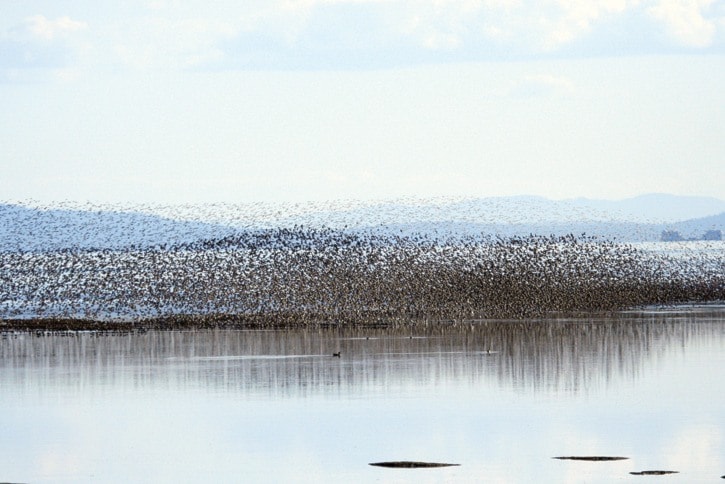Birds’ mastery of flight is no better exemplified than when they gather in flocks.
Shorebirds perform graceful aerobatics over the mudflats, geese travel from the Arctic in V-shaped skeins and crows fly in orderly lines as they converge on a roosting site.
I wonder how many generations of people have marveled at these sights?
Small sandpipers, such as dunlin, form looping, cloud-like flocks as a defence against predatory falcons. A flock can comprise thousands of birds, moving as one, in almost perfect synchronicity.
Studies since the 1970s – by J. Michael Davis, Wayne Potts and others – show that a rotation by one bird can set off a chain reaction that spreads through the entire flock, causing the group to turn from dark to light (or vice versa) in a flash.
The wave of motion quickly speeds up until the flock as a whole is reacting much faster than the birds could as individuals.
Potts called this the ‘chorus-line effect.’
Flocks typically clump into a tighter group when menaced by a predator, with each individual bird turning inwards towards the average position of the group. Turning outwards, the bird would become isolated and vulnerable to attack.
The same type of motion is seen in schooling fish, such as herring, that bunch into a tight ball. Birds take it a wing flap further, by twisting into ribbons of alternating light and dark, that give the whole flock a mysterious fluid look.
The flight of snow geese, in contrast, is comparatively stately. Skeins of two or three hundred birds travel hundreds of miles, the lead bird flying for a short time before sliding back into the group and another taking its place.
The V-shaped formation is highly energy-efficient, as demonstrated regularly by cyclists, slip-streaming in each other’s wake.
Crows are not everyone’s favourite, yet their intelligence and social behaviour are among the most advanced of all birds.
From late summer onwards, adults and young crows gather in communal roosts, typically choosing city buildings where they are safe from predators.
They form groups at staging areas en route, often with much calling and fuss, suddenly taking wing all together, as they join the ritual evening procession.
Thousands of these birds converge on a few blocks, flying in from great distances in long straggling lines, as the light fades from the sky.
The suburbs are forsaken and the crows take over the town.
Anne Murray is the author of A Nature Guide to Boundary Bay and Tracing Our Past ~ A Heritage Guide to Boundary Bay, both available at bookstores or online at www.natureguidesbc.com.
